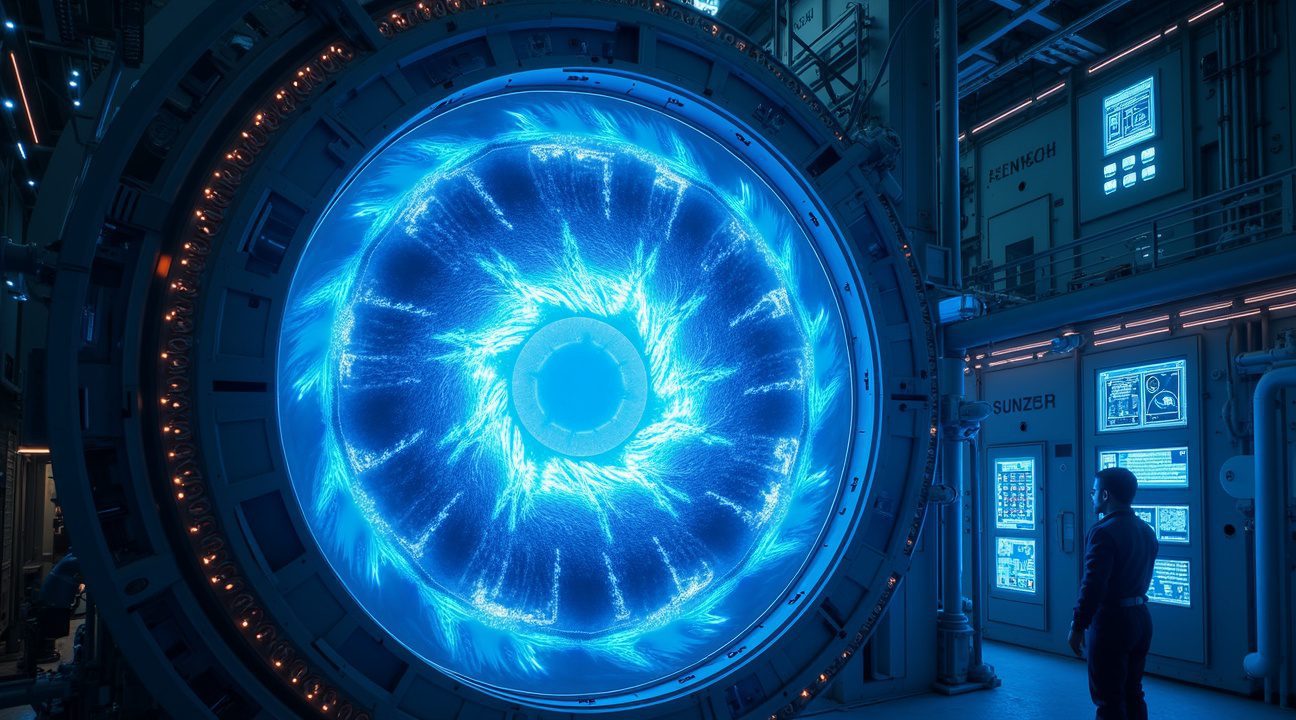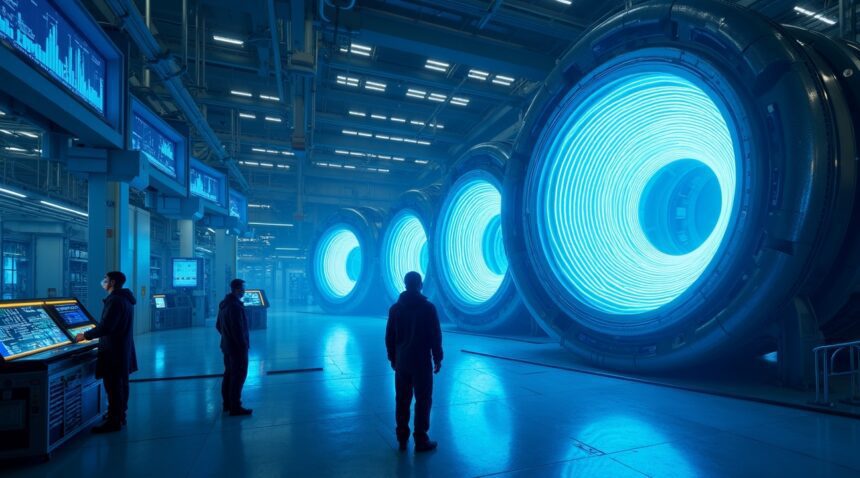Germany’s €2 Billion Fusion Energy Initiative: A Bold Investment in the Future
Germany’s coalition government has announced an ambitious fusion energy program, dedicating over €2 billion through 2029 to advance both stellarator and laser fusion technologies, signaling a determined stride toward leadership in the global fusion arena.
Key Takeaways
- Germany has committed more than €2 billion toward advancing fusion research through 2029, supporting both stellarator-based magnetic confinement fusion and laser-driven inertial fusion technologies.
- The Wendelstein 7-X stellarator made global headlines in February 2023 by sustaining plasma for an unprecedented 8 minutes, involving an energy turnover of 1.3 gigajoules.
- Current German fusion facilities serve purely experimental functions, with a focus on plasma physics research rather than electrical power generation and no connections to the electrical grid.
- German startups like Proxima Fusion and Marvel Fusion are participating in the global race to commercialize fusion, offering magnetic and laser-based solutions, respectively.
- Major engineering challenges remain, including consistent net energy gain, affordability of reactor construction, and scalability for future commercial power stations.
Scientific and Technical Progress
The Wendelstein 7-X stellarator, based in Greifswald, Germany, represents a pinnacle in magnetic confinement fusion research. In 2023, it set a new record for plasma duration, offering proof that steady plasma confinement is achievable. This milestone showcases Germany’s technical capability but also highlights the distance remaining before fusion becomes commercially viable.
Despite these advances, experimental reactors like the Wendelstein remain primarily research tools. Their objective is to understand plasma behavior, magnetic confinement optimization, and system efficiency. None are currently equipped to feed power into the grid or operate continuously to provide usable electricity supply.
Germany’s Multi-Pronged Strategy
Germany’s investment strategy embraces diversification. Researchers are developing both magnetic confinement methods, such as those used by stellarators, and laser-driven inertial fusion systems. This twin approach acknowledges the early stage of fusion development and avoids putting all institutional support behind a single uncertain technology.
Startups such as Proxima Fusion and Marvel Fusion are key players in this landscape. Proxima focuses on stellarator innovation with enhanced engineering models, while Marvel pioneers a different path using advanced laser-compression for fast inertial fusion ignition. Each represents a different route toward the shared goal of sustainable power production.
Technical Challenges and Industry Hurdles
Fusion reactions to date consume more energy than they produce. Achieving a consistent net energy gain remains the Holy Grail. In addition, the cost of rare materials, complex control systems, and the scale of construction presents barriers to commercial deployment. These challenges place fusion behind more mature renewables, but the long-term payoff promises carbon-free, virtually inexhaustible power.
- Net energy gain must be demonstrated reliably.
- Engineering must solve thermal management and magnet-based confinement challenges.
- Capital involved in building reactors must be reduced to attract more investment.
- Technologies must prove scalable to global infrastructure systems.
Strategic and Economic Opportunity
Germany’s large public investment shows strong governmental belief in fusion’s potential. However, true success will depend on long-term political and financial continuity, transcending short-term election cycles. Commercialization will likely extend past current leadership, requiring policies that can endure through various administrations.
Partnership between the public and private sectors enhances this trajectory. Government laboratories provide foundational science, while startups innovate rapidly and competitively. The synergy of public stability with private agility fosters an environment ripe for breakthroughs and rapid development.
Germany’s Role in the Global Fusion Ecosystem
German researchers maintain active roles in international projects like ITER, strengthening global cooperation. At the same time, Germany develops internal capability and infrastructure to remain competitive. This dual approach allows for both independent breakthroughs and shared learning from major global ventures.
Increased private investment is a notable trend worldwide, with more than 50 startups pursuing fusion in different forms. Germany’s early support and generous funding likely positions its companies favorably in the race for patents, technology leadership, and future export opportunities in clean energy solutions.
Conclusion
Germany’s €2 billion fusion energy investment is more than a bet on tomorrow—it’s a calculated and strategic move to secure energy sovereignty and gain leadership in a vital clean-energy frontier. Achieving commercial fusion remains challenging, but Germany is laying the groundwork through public support, private innovation, and global collaboration to make that future a reality.
Germany Launches €2 Billion Fusion Energy Plan to Build World’s First Commercial Plants
Germany’s coalition government has positioned fusion energy at the center of an ambitious energy transformation strategy. I’ve observed this commitment crystallize through their comprehensive ‘High-Tech Agenda’ and specialized ‘Fusion Action Plan’, which together establish fusion power plants as fundamental pillars of the nation’s energy and climate policy.
The financial backing demonstrates serious intent. Over €2 billion has been allocated through 2029 specifically for fusion research, infrastructure development, and pilot projects. This substantial investment reflects Germany’s determination to lead the global transition away from traditional energy sources and establish itself as the premier destination for commercial fusion technology.
Dual-Track Technical Approach
Germany’s strategy employs a sophisticated dual-track methodology that maximizes the potential for breakthrough success. The plan simultaneously pursues magnetic confinement fusion technology, exemplified by advanced stellarators like the Wendelstein 7-X facility, alongside laser-driven inertial fusion systems. This parallel development approach reduces technological risk while accelerating potential timelines for commercial deployment.
- Magnetic Confinement Fusion: Stellarators like the Wendelstein 7-X offer inherent stability advantages and are leading candidates for sustained commercial operation. The Wendelstein 7-X has already demonstrated critical proof-of-concept capabilities that inform the scaling pathway for future commercial plants.
- Laser-Driven Inertial Fusion: This complementary technological pathway uses powerful laser arrays to compress fuel pellets, triggering fusion reactions through different physical mechanisms than magnetic confinement.
By pursuing both technologies simultaneously, Germany positions itself to capitalize on whichever approach achieves commercial viability first.
Regulatory Framework and Strategic Vision
The proposed ‘Fusion Energy Act’ represents a critical enabling component of Germany’s fusion strategy. This dedicated legal framework will establish clear regulatory pathways for fusion technology deployment, removing bureaucratic barriers that could delay commercial implementation. I anticipate this legislation will serve as a model for other nations developing their own fusion regulatory structures.
The CDU/CSU’s ‘New Energy Agenda for Germany’ frames fusion as more than just another energy source. Party leadership explicitly identifies fusion as a transformative game changer for global energy systems and positions it as the critical pathway for achieving climate neutrality goals. This political consensus across major parties ensures continuity regardless of future electoral outcomes.
Strategic planning extends beyond immediate deployment goals. The ‘Fusion Energy Research and Innovation Roadmap (FIRE)’ scheduled for release by 2026 will provide detailed timelines and specific milestones for commercial fusion deployment. This roadmap will likely include:
- Performance benchmarks for fusion technologies
- Funding allocation schedules through 2029
- International partnership frameworks with research institutions and private enterprises
Germany’s comprehensive approach addresses the full spectrum of fusion development challenges. Research investments target fundamental plasma physics questions while infrastructure spending supports the specialized facilities required for fusion testing and production. Pilot projects bridge the gap between laboratory demonstrations and commercial-scale deployment, providing essential operational experience before full grid integration.
The timeline for space exploration parallels the ambitious goals Germany has set for fusion energy development. International collaboration will prove essential as fusion technology requires expertise spanning multiple scientific disciplines and engineering specialties.
Political momentum continues building as environmental pressures intensify and energy security concerns mount. Germany’s fusion initiative represents a calculated bet that breakthrough technologies can solve multiple challenges simultaneously — climate change, energy independence, and economic competitiveness. Success would establish Germany as the global leader in what many consider the ultimate clean energy technology.
Commercial fusion deployment faces significant technical hurdles, but Germany’s systematic approach and substantial financial commitment create favorable conditions for success. The dual-track strategy, comprehensive regulatory framework, and long-term political support provide a foundation that previous fusion efforts have often lacked.
Wendelstein 7-X Breaks World Records with 8-Minute Plasma Duration
I’ve witnessed remarkable breakthroughs in fusion technology, but the Wendelstein 7-X at the Max Planck Institute for Plasma Physics represents something truly extraordinary. This massive stellarator stands as the world’s largest and most advanced of its kind, pushing the boundaries of what’s possible in controlled fusion reactions.
February 2023 marked a historic milestone when the Wendelstein 7-X shattered its own world record by maintaining hot plasma for an unprecedented 8 minutes. This achievement delivered an energy turnover of 1.3 gigajoules, representing a staggering 17-fold increase over its previous record of 75 megajoules. Such dramatic improvements demonstrate the rapid advancement in fusion technology that many thought would take decades to achieve.
Advanced Heating and Fuel Delivery Systems
The reactor’s impressive performance stems from its sophisticated engineering systems that work in perfect harmony. During the record-breaking run, the device sustained an average heating power of 2.7 megawatts, supported by up to 12 gyrotron heating modules. Each module can deliver over 1 megawatt of power, providing the intense energy needed to maintain plasma temperatures exceeding 100 million degrees Celsius.
Equally important is the fuel delivery system that enables these extended operations. A new steady-state pellet injector, developed through collaboration with Oak Ridge National Laboratory, allows consistent hydrogen fuel delivery throughout the plasma duration. This innovation addresses one of fusion’s biggest challenges – maintaining steady fuel supply during extended operation periods without disrupting the delicate plasma equilibrium.
The Wendelstein 7-X serves as more than just a research instrument; it’s a comprehensive testbed for demonstrating long-duration, stable fusion plasmas under conditions that mirror requirements for future commercial power plants. Unlike traditional tokamak designs that suffer from inherent instabilities, the stellarator’s twisted magnetic field configuration offers superior plasma confinement over extended periods.
These achievements position Germany at the forefront of fusion research, with the Wendelstein 7-X proving that sustained fusion reactions aren’t just theoretical possibilities but practical realities. The 8-minute plasma duration represents a crucial step toward continuous operation, bringing us closer to the dream of unlimited clean energy that could transform how we power our civilization.

Reality Check: Current Fusion Timeline vs. Grid Connection Claims
The excitement surrounding Germany’s fusion research has generated some extraordinary claims, but it’s important to separate fact from fiction regarding current capabilities and realistic timelines. Wendelstein 7-X and other German fusion facilities remain firmly in the experimental phase, with no connections to the electrical grid whatsoever.
What These Facilities Actually Do
These research installations serve a fundamentally different purpose than power generation plants. The facilities focus on advancing plasma physics research and validating critical engineering principles rather than producing electricity for consumption. Wendelstein 7-X specifically operates as a stellarator designed to test sustained plasma confinement — a crucial step before any fusion reactor can generate power. Scientists use these experiments to understand how to maintain the extreme conditions necessary for fusion reactions, including temperatures exceeding 100 million degrees Celsius.
The research conducted at these facilities addresses several key challenges that must be solved before commercial fusion becomes viable:
- Plasma stability and confinement optimization
- Materials science for reactor components that can withstand neutron bombardment
- Heat extraction and conversion systems
- Tritium breeding and fuel cycle management
- Remote maintenance technologies for radioactive environments
Germany’s official timeline presents a more measured approach than sensational headlines suggest. Policymakers anticipate the first demonstration fusion power plant could emerge within this decade, with 2029 established as a significant policy milestone for launching major pilot projects. This timeline reflects the substantial technical hurdles that remain unsolved.
Gauss Fusion GmbH has made notable progress by releasing the first complete design blueprint for a commercial gigawatt-scale fusion plant, with expectations for completion by 2025. However, designing a plant and building one represent vastly different challenges. The blueprint represents an important step forward, but it doesn’t guarantee successful implementation or operation.
I find no credible evidence supporting claims that any German fusion facility will connect to the grid by 2030, much less power the entire planet. Such assertions appear to misrepresent the current state of fusion technology and the realistic development timeline. The physics and engineering challenges that have puzzled scientists for decades won’t disappear overnight, regardless of recent advances.
Current fusion experiments, including those at Wendelstein 7-X, consume far more energy than they produce. Achieving net energy gain — where a fusion reaction produces more energy than it consumes — remains the holy grail of fusion research. Even after achieving this milestone in laboratory conditions, scaling up to commercial power generation requires solving countless additional engineering problems.
The path from experimental success to commercial deployment typically spans decades in complex energy technologies. Nuclear fission, for comparison, took approximately 30 years from the first controlled reaction to widespread commercial adoption. Fusion presents even greater technical challenges than fission did.
Germany’s fusion research represents genuine scientific progress, and the country continues investing heavily in this technology. Multiple research institutions collaborate on solving different aspects of the fusion puzzle, from plasma physics to materials science. This work is valuable and necessary for eventual commercial fusion deployment.
Yet claiming that current German fusion facilities will soon connect to the grid or power the planet by 2030 misrepresents both the current technology status and the realistic development timeline. These experimental facilities serve their intended purpose of advancing scientific understanding, but they’re not designed or capable of commercial electricity generation.
The fusion energy field benefits from honest assessment of current capabilities and realistic timelines. While space exploration has shown how ambitious technological goals can be achieved, fusion energy requires acknowledging both its tremendous potential and the significant challenges that remain before that potential becomes reality.
Fusion’s Promise as Climate Solution Faces Engineering Reality
German policymakers have positioned fusion energy as a potential ‘game changer’ for meeting future electricity demands, particularly as consumption is projected to increase by 2 to 3 times by 2050. This assessment reflects the urgent need for clean energy alternatives as traditional power sources struggle to meet growing global demands while addressing climate concerns.
The Environmental and Safety Advantages
Fusion technology offers several compelling advantages over conventional energy sources. The process produces no direct CO₂ emissions during operation, making it an attractive solution for countries working to meet aggressive climate targets. Unlike nuclear fission, fusion generates significantly less radioactive waste and eliminates the catastrophic meltdown risks that have historically plagued nuclear power facilities.
I find the safety profile particularly noteworthy because fusion reactions naturally self-regulate — if containment fails, the reaction simply stops rather than escalating into a dangerous situation. This characteristic addresses many public concerns about nuclear technology while maintaining the high energy output potential that renewable sources like solar and wind can’t consistently provide.
Global Competition and German Innovation
The international race to develop commercially viable fusion power has intensified, with more than 50 startups worldwide competing to create the first fusion system capable of supplying power to electrical grids. Germany has emerged as a significant player in this competition, hosting several innovative companies pushing the boundaries of fusion technology.
German companies are taking diverse approaches to solve fusion’s technical challenges:
- Proxima Fusion focuses on stellarator technology, building on decades of German research
- Marvel Fusion explores laser-driven fusion using advanced target designs
- Focused Energy develops inertial confinement fusion systems
- Gauss Fusion works on magnetic confinement approaches with novel reactor designs
These companies represent different technological pathways, each attempting to overcome the fundamental challenge of creating more energy than the system consumes while maintaining stable, continuous operation.
Despite the optimism surrounding these developments, significant engineering hurdles remain. Space exploration endeavors have demonstrated how ambitious technological goals often face unexpected delays and complications, and fusion energy presents similarly complex challenges.
Cost-efficiency remains a critical concern for fusion’s commercial viability. Building and maintaining fusion reactors requires extraordinary precision and expensive materials capable of withstanding extreme temperatures and radiation. The magnetic fields needed to contain fusion plasma demand superconducting magnets that operate at near absolute zero temperatures, creating additional complexity and expense.
Scalability presents another significant challenge. Even if researchers achieve net energy gain in laboratory conditions, scaling the technology to power entire cities or countries requires solving manufacturing, maintenance, and infrastructure problems that haven’t been fully addressed. The engineering tolerances required for fusion reactors exceed those of most existing industrial processes.
Current fusion devices worldwide have yet to achieve net energy gain — the critical milestone where a reactor produces more energy than it consumes. This fundamental requirement must be met before fusion can contribute meaningfully to electrical grids. Recent technological breakthroughs in other fields show how persistent research can overcome seemingly impossible barriers, but fusion’s timeline remains uncertain.
The promise of fusion energy connecting to electrical grids soon represents an ambitious goal that must be balanced against technical realities. While German companies and international competitors continue making progress, the gap between laboratory demonstrations and commercial power generation remains substantial. Each breakthrough brings the technology closer to practical application, but experts consistently emphasize that significant engineering challenges must be resolved before fusion can fulfill its potential as a climate solution.
Sources:
Clean Energy Wire: “Germany advances plans for world’s first fusion power plant in ‘High-Tech Agenda'”
Fusion Industry Association: “Germany’s New Government Readies for a Push Towards Fusion Power”
Max Planck Institute for Plasma Physics press releases on Wendelstein 7-X
Interesting Engineering: “Wendelstein 7-X: Experiments to resume on world’s largest stellarator”
World Nuclear News: “Gauss Fusion releases blueprint for development of its GIGA fusion plant”
Le Monde (EN): “Nuclear fusion: The race among start-ups to harness limitless, clean energy”
Wikipedia: “Wendelstein 7-X”


